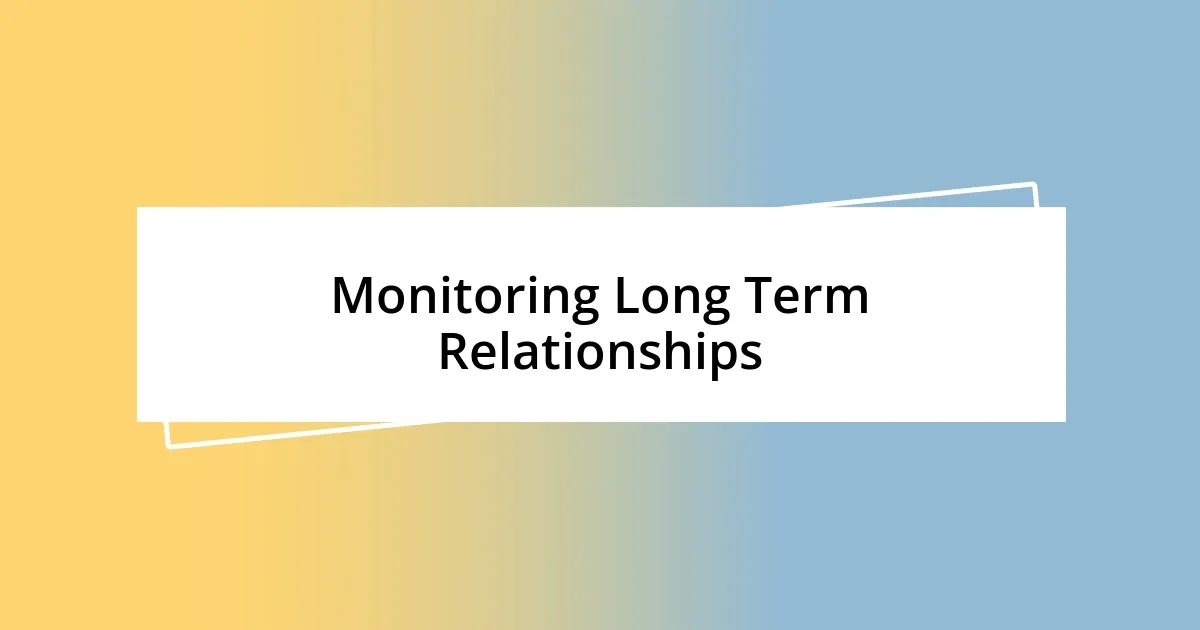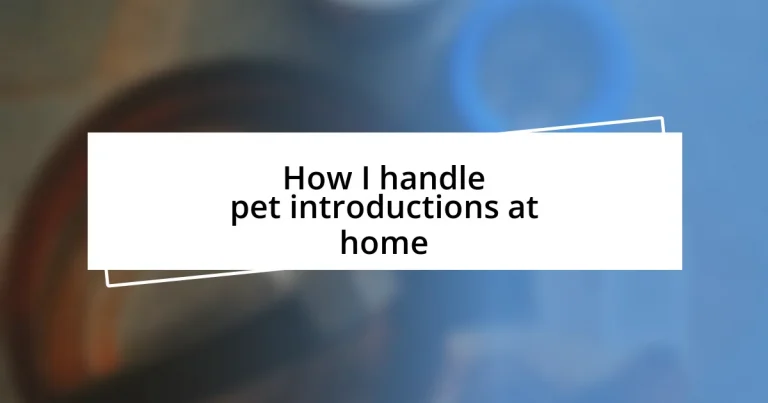Key takeaways:
- Creating a calm environment and separate spaces for pets can ease anxiety and foster safety during introductions.
- Supervising initial meetings and observing body language helps identify stress signals and ensure positive interactions.
- Gradually increasing interaction in controlled settings promotes comfort and trust between pets over time.
- Monitoring long-term relationships through consistent observation and positive reinforcement strengthens bonds between pets.

Preparing for Introductions
Preparing for pet introductions at home is an essential step in ensuring a smooth transition for everyone involved. I remember the first time I introduced my rescue dog to my family’s cat; it was a nerve-wracking experience. There’s something about the tension in the air that makes you wonder—will they get along, or is chaos just around the corner?
Before the big day, I always create a calm and secure environment. This might mean setting up separate spaces for each pet, complete with their favorite toys and cozy beds. When I did this for my newest kitten, I noticed how much more relaxed she felt knowing she had her own territory to retreat to. It’s incredible how a little preparation can ease those initial jitters and foster a sense of safety.
One key element I focus on is scent swapping. You’d be surprised at how much pets rely on their sense of smell to navigate their world! When I brought home my second dog, I made sure to have them sniff each other’s blankets beforehand. This simple step seemed to help break the ice, allowing them to familiarize themselves with one another in a non-threatening way. Isn’t it fascinating how these little actions can set the stage for harmony?

Choosing the Right Environment
Choosing the right environment for pet introductions can significantly impact the outcome. When I first brought home my older cat and introduced her to my puppy, I created a separate, quiet area in my living room. That way, my cat felt safe to observe the newcomer without feeling cornered, which eased her anxiety and allowed for a more gradual introduction.
I’ve also learned that timing plays a crucial role. For instance, I organized the introduction early in the day when both pets were more relaxed and had plenty of energy to explore. It was incredible to see how their curiosity peeked; my cat was more playful and my puppy was eager to make a new friend. Choosing moments like these can help set the stage for a positive experience.
Finally, ensure the environment is distraction-free. The last thing you want is to introduce your pets amidst loud noises or a flurry of visitors. Once, I made that mistake, and it turned into chaos! I had to restart the introduction after my friends left. A calm space can truly make all the difference.
| Factor | Tip |
|---|---|
| Space | Provide separate areas for pets to retreat to. |
| Timing | Choose a quiet time of day for introductions. |
| Distractions | Avoid loud noises or many people during the introduction. |

Supervising Initial Meetings
Supervising initial meetings is a crucial part of pet introductions, and I can’t emphasize enough how attentive observation makes a difference. When I was introducing my cat to my new puppy, I realized that staying present meant the world. I could see the subtle cues each of them was giving; my puppy’s playful tail wagging contrasted with my cat’s wary, twitching ears. By reacting to those signals right away, I could easily intervene if things felt too tense or if playfulness crossed into aggression.
It’s all about being proactive, rather than reactive. Here are some tips that have worked for me:
- Watch body language: Look for signs of stress or discomfort, like growling, hissing, or stiff posture.
- Keep sessions short: Initially, limit each meeting to a few minutes to prevent overwhelming either pet.
- Redirect attention: If one pet gets too riled up, use treats or toys to distract and redirect their focus.
- Reward good behavior: I always have treats handy. Rewarding calm, friendly interactions reinforces positive behavior.
- Be patient: Sometimes, it takes multiple meetings for pets to adjust, so don’t rush the process.
In my experience, creating a balance of supervision and allowing them to interact naturally often leads to the best outcomes. As I watched them slowly acclimate to each other, it was heartwarming to see the curiosity ease into comfort, proving that sometimes, a little patience pays off big time.

Understanding Body Language Signals
Understanding the body language of pets during introductions is essential. I remember the first time my dog met my neighbor’s cat. As my dog approached, her body language was full of excitement—a wagging tail, a relaxed posture—but my neighbor’s cat was the exact opposite. With her ears pinned back and a twitching tail, it was clear she felt threatened. It hit me then: reading these signals could either make or break that encounter.
It also helps to recognize nuances. When my cat first met my dog, I noticed her body language shifting. Initially, she was tense and kept her distance. But as she began to approach slowly, with her tail high—a sign of confidence—I felt my heart race with hope. I eagerly watched for signs of curiosity from both sides. It’s fascinating, isn’t it? How a slight change in posture or tail position can signal so much about what our pets are feeling.
In my experience, understanding these signs not only fosters a more comfortable environment but also strengthens your bond with your pets. Have you ever seen a pet’s body language shift dramatically in response to another? That moment of realization, when you understand they’re more than just animals, but beings with feelings, can be truly enlightening. I often find myself reflecting on how these interactions shape their confidence in new experiences.

Establishing Safe Spaces
Establishing safe spaces for pets is paramount during introductions. I always designate a specific area in my home as a “neutral zone” before any meeting. This way, my pets can explore and feel comfortable without the pressure of confronting each other head-on right away. It’s a bit like creating a warm welcome mat for them—inviting, yet non-threatening.
I recall the first time I set up a safe space for my shy kitten when we welcomed a boisterous dog. I provided a cozy nook with her favorite toys and a soft blanket, ensuring it was a sanctuary she could retreat to at any time. Watching my kitten find solace in her little fortress was heartening; it reassured me she had a place to decompress whenever the introductions became overwhelming. Isn’t it fascinating how having a personal haven can help alleviate stress for our pets?
In my experience, each time I introduce new animals, I remind myself to offer them both a sense of security. This means ensuring exits are clear and they have places to retreat. It’s such a simple step, yet it goes a long way in preventing anxiety. I’ve found that when my pets know they can escape if needed, they’re more likely to approach each other on their own terms. What strategies have you employed to create safe spaces for your pets during such introductions?

Gradually Increasing Interaction
Gradually increasing interaction is crucial in establishing a harmonious relationship between pets. I find that starting with short, supervised visits can be incredibly effective. The first time I allowed my cat and dog to see each other from a distance, I felt a mix of anticipation and anxiety. They were both curious yet cautious, which reinforced my decision to keep those initial meetings brief and positive.
As they grew more comfortable, I began incorporating short play sessions with a barrier, like a baby gate. This approach not only provided a visual barrier but also a sense of security. I still remember the first time I witnessed my cat stretch over the gate to swipe at a toy I was holding, while my dog wagged her tail in excitement! It was a small victory that made me realize they could interact playfully without feeling threatened. Can you relate to those little moments of joy as your pets begin to trust each other?
Encouraging gradual interactions allows me to monitor their body language closely. When I sense either pet feeling overwhelmed, I step back, giving them space to regroup. It’s interesting how patience can transform tentative glances into playful nudges over time. I often think back to those early days when my dog’s enthusiasm contrasted sharply with my cat’s wariness. Now, they play together as if they’ve always been best friends. How do you approach these pivotal moments in your own pet introductions?

Monitoring Long Term Relationships
Monitoring long-term relationships among pets is a delicate task that requires continual observation and understanding. I’ve learned to pay close attention to their interactions over weeks and months, noticing the little changes in their dynamics. For instance, there was a time when my dog would steal toys from my cat’s space, which led to some tense moments. But with time, I’ve seen how, through gentle reminders and positive reinforcement, the two have developed a playful negotiating style. It’s incredible to witness how trust builds over time, isn’t it?
I also find it essential to check in on how each pet is feeling as their relationship grows. There have been moments when my cat would look a bit on edge, while my dog seemed oblivious to her discomfort—these signals are vital clues. I remember one specific day when, during a sunny afternoon, I noticed my cat suddenly retreating to her safe space while my dog was energetically bounding around the room. I paused our playtime, giving my cat the chance to rejoin when she felt ready. Doesn’t it feel satisfying to know your pets can communicate their needs if we just take a moment to listen?
Lastly, maintaining a balance is key; I continuously rotate activities that keep both pets engaged without overwhelming any one of them. Recently, I’ve started incorporating treat time together—separately at first, then side by side, guiding them to associate each other with positive experiences. It’s an ongoing journey of creating shared moments, fostering companionship, and ensuring they both feel valued in our home. Have you discovered any particular activities that help strengthen bonds between your pets?














